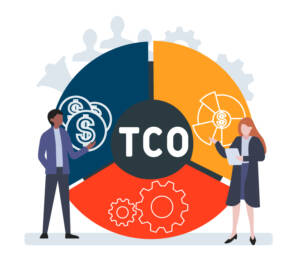Hidden Costs of Ownership: What To Consider When Considering TCO

 If you have a mobile workforce, you have different options when it comes to equipping them with the electronic devices, IT capacity, and telephony services needed to carry out their work with maximum efficiency.
If you have a mobile workforce, you have different options when it comes to equipping them with the electronic devices, IT capacity, and telephony services needed to carry out their work with maximum efficiency.
On the one hand, you can look to an outsourced provider of such solutions to supply both the equipment and the support services needed to keep everything running, ensuring that in partnership, you have everything you need while also being able to update when necessary and call on the expertise of specialists to solve problems and maintain operational continuity.
The alternative is to do everything in-house, relying on a combination of equipment you have bought yourself, in-house technical experts, plus your staff using their own devices and their personal knowledge.
In the second instance, the option of purchasing an in-house solution must be weighed against the cost of paying for a partner solutions provider to work alongside you.
If you take the in-house option, you are paying for assets you will fully own, but the price you pay upfront is just part of the equation. When other elements are factored in, you have what is known as total cost of ownership (TCO).
According to Wall Street Mojo, TCO can be defined as a formula. The first factor is the upfront cost you pay, but others will include direct, indirect, and hidden costs. This can include the costs of maintenance, the costs of operating devices, and also the salvage cost; is the asset worth anything when it comes to the end of its working life? (think of selling a car for scrap as an example).
The last of these will be a deduction that can be made from the cost after all the other elements have been added up, with the final figure giving you the TCO.
However, the reality is that your TCO will be a very complex and tricky thing to work out, not least because there are so many hidden costs and potential costs involved that you can easily underestimate it.
When acquiring devices, the first thing to note is you are not buying unbreakable equipment or something that will never have a fault, so the first indirect cost to consider is a replacement – and you won’t know how often that will be necessary.
Since you don’t want to be in a situation where business continuity is impeded by an equipment failure, the practical step to take is to invest in spare equipment so you can replace malfunctioning devices promptly. That means your purchase of equipment will always require buying more than just the number of devices your workforce will be using at any given time.
If you do take a chance on only having as much equipment as you will be using at any one time and replacing it only once a fault arises, this may save money in the short term, but the TCO will then have to factor in a downtime cost: How much lost output arises in the time period between when a piece of equipment fails and its replacement arrives.
There is also the matter of back-up equipment. If you have a mobile workforce and a lot of mobile telephony is involved in what you do, there will be a need to charge phones, while others will need to use USB devices.
This can be very tricky if you rely on staff to use their own phones. Because batteries are not separately chargeable in consumer cell phones, to be able to charge everyone up means more charging equipment that will take up lots of room. This in turn, might reduce space for other productive equipment, or what economists would refer to as opportunity cost.
Another point to bear in mind is that, with BYOD consumer devices and even some competitive enterprise devices, the entire phone needs to come out of circulation to charge, which means you need to keep additional devices on hand for staff members to use while other devices are charging. However, with devices like Spectralink enterprise smartphones, batteries can be charged separately, so you only need to ensure a steady supply of batteries in order to keep everyone connected.
 Moreover, the phones themselves only have a certain lifetime, with consumer phones only generally being good for a couple of years and enterprise phones for five. There can be a recovery amount when a phone is sold, although if it is getting obsolete, the fee will be lower.
Moreover, the phones themselves only have a certain lifetime, with consumer phones only generally being good for a couple of years and enterprise phones for five. There can be a recovery amount when a phone is sold, although if it is getting obsolete, the fee will be lower.
There are very good reasons to sell an old phone, not least that by recycling it, the device won’t end up leaching toxic chemicals into the ground at landfill sites as it decays. However, if it is in part-exchange the deals on a new device will not always be that favourable, so this salvage cost factor is not exactly gold-plated.
There is also the importance of making sure all data is wiped from a phone before it gets to be reused, since this brings obvious perils. However, security issues are not confined just to the disposal of old devices.
A major security concern relates to the whole notion of bring your own device (BYOD). On the one hand, BYOD can be seen as a major saving factor in the overall TCO, since you won’t have to pay for smartphones, laptops and other equipment if your staff are bringing their own.
Indeed, a study by Cisco found that in the US, BYOD saved firms an average of $3,150 (£2,600) per employee each year in the areas of hardware, telecommunications, support and training.
However, this has to be set against the extra security costs that can arise through BYOD. If you have a centralised, office-based system, especially if run with a telephony partner, you can get consistent support and focus on maintaining vital security systems.
By contrast, that can never be the case with BYOD. Firstly, users will not necessarily take the same steps to keep their security updated. Second, they may not have the expertise to spot threats and, third, because these are personal devices, their usage may involve activities that expose them to greater risks, such as visiting unsecure websites.
There are also apps that can be particularly risky for phones, such as TikTok. To similarly compel employees not to have this or other apps on their phones might be seen as a breach of the freedoms of staff to use their own property as they wish, which would make BYOD unappealing for staff, who will otherwise enjoy the ability to switch swiftly and seamlessly between personal and work use on their devices.
However, at the same time there are many more risky apps out there. Tech Beacon notes that apps were mostly “developed without any concern for security” and lists the 20 it considers the most dangerous, including Pokemon Go, WeChat, WhatsApp Messenger and Facebook Messenger. All these are just the riskiest in a list that is far from exclusive.
Any breach of security via BYOD could have all kinds of serious consequences for your firm. The leakage of data could directly cost you a lot of money as well as in indirect ways, such as confidential information ending up in the hands of rivals or cyber-criminals.
In addition, because staff’s own devices may be linked up to those in an in-house system, any security breach may have knock-on effects, so further remedial work will be needed to fix security breaches, replace passwords and so on.
All of these are prime examples of hidden costs, as is the cost of buying protective cases for consumer devices. They won’t appear on the balance sheet when you are buying equipment, but they can pop up later and upset your estimates of overall TCO.
In summary, the TCO equation can have many more elements than you might initially factor in when planning an asset acquisition strategy for your IT, Wi-Fi and telephony services.
You will need to consider it a multi-year investment even if the initial acquisition costs are all upfront, because you will face a varied mix of ongoing costs, eventual replacement costs and, potentially, sudden and unexpected extra expenses such as having to deal with equipment breakages, system failures and major security crises.
It is for all these reasons that the complexity of calculating a TCO is immense and even the best estimates can be imprecise. It makes a lot of sense, therefore, to work with a partner organization like Spectralink that can help supply and maintain your telephony needs and help you manage costs in a more coherent, sustainable and consistent way.
For more information on complete mobility solutions from Spectralink, including devices, support services, maintenance, and more, complete the form below.
